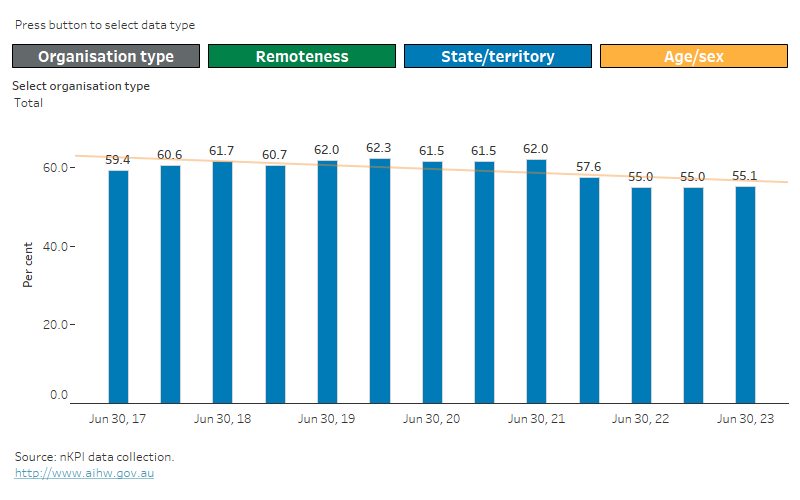Alcohol consumption (PI16)
This indicator is the proportion of First Nations regular clients aged 15 and over who had their alcohol consumption status recorded within the previous 24 months.
It is collected for males and females in age groups:
- 15–24
- 25–34
- 35–44
- 45–54
- 55–64
- 65 and over.
Why recording alcohol consumption is important
Alcohol consumption refers to the consumption of drinks containing ethanol, commonly referred to as alcohol. The quantity, frequency or regularity with which alcohol is drunk provides a measure of the level of alcohol consumption.
The harmful use of alcohol has both short-term and long-term health effects. Short-term effects are mainly related to potential injury suffered by the drinker and/or others who may be affected by the drinker’s behaviour. Over the longer term, excessive alcohol consumption is associated with a variety of adverse health and social consequences. It is a major risk factor for conditions, including liver disease, pancreatitis, heart disease, stroke, diabetes, obesity and some types of cancer. It is also linked to social and emotional wellbeing, mental health and other drug issues. Alcohol use during pregnancy is associated with severe adverse perinatal outcomes, such as foetal alcohol syndrome and alcohol-related birth defects and developmental disorders.
Data from the Australian Bureau of Statistics’ 2018–19 National Aboriginal and Torres Strait Islander Health Survey show that the proportion of First Nations people aged 15 and over who did not drink alcohol in the last 12 months has increased in recent years, and they were also more likely than non-Indigenous Australians to have not drunk alcohol in the previous 12 months (AIHW 2023).
At June 2023, 55% (or around 150,000) of First Nations regular clients aged 15 and over had their alcohol consumption status recorded within the previous 24 months (Figure 1).
Figure 1: Alcohol consumption status recorded by reporting period
Smoking status result by reporting period
This Tableau visualisation shows the percentage of First Nations regular clients aged 11 and over who had their smoking status recorded in the last 2 years by smoking status result (select for both ex-smoker and never smoked, current smoker, ex-smoker, or never smoked) for either:
- type of organisation (ACCHO, non-ACCHO)
- remoteness area (Major cities, Inner regional, Outer regional, Remote, Very remote)
- state/territory (NSW/ACT, Vic, Qld, WA, SA, Tas, NT)
- age/sex (male, female with age group 11–14, 15–24, 25–34, 35–44, 45–54, 55–64, 65+).
There are two different time periods:
- June 2021 to June 2023
- June 2017 to December 2020.
Data supporting this visualisation are available in Excel supplementary data tables at Data.

Note: For more information, including on interpreting changes over time, see Technical notes.
For more information on alcohol consumption see Data.
Reference
AIHW (Australian Institute of Health and Welfare) (2023) Aboriginal and Torres Strait Islander Health Performance Framework: risky alcohol consumption, AIHW, Australian Government, accessed 11 December 2023.


